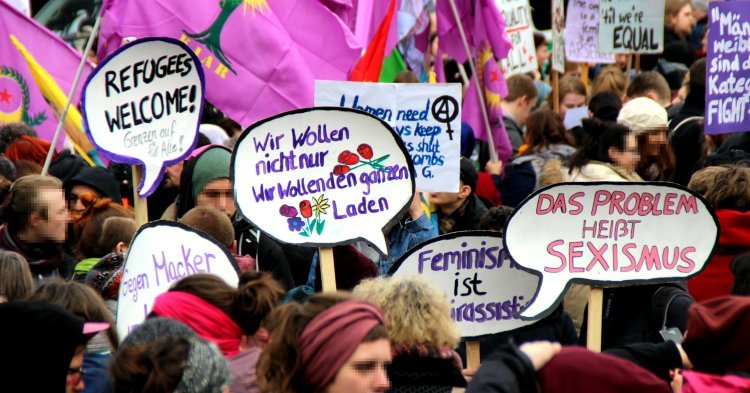Against “new forms of partnership between men and women, against measures for legal equality of women and against the equality of LGBT, […] against the ’the elites’ and against ’the others’”: That is how Birgit Sauer described the manifold enemy images of anti-feminist mobilisation in an essay. The anti-feminist movement’s goals include not only a return to traditional ideas of gender and sexuality. It also propagates further anti-democratic ideas as well as an image of citizens who are dependent on the leadership and protection of right-wing populists.
Since 2006, Sauer has been a university professor with a focus on gender and governance at the Institute for Political Science at the University of Vienna. Previous guest professorships have taken her to Mainz, Seoul (South Korea) and Boca Raton (Florida). For her contribution to feminist political science she was awarded the Austrian State Prize for Women’s Studies, Gender Studies and Equality in the World of Work, the Käthe-Leichter-Prize, in 2015. In her research, Sauer among other topics looks at the interface between (anti)feminism and right-wing populism. Her essay, quoted at the beginning of this article, succeeds in demonstrating how important the European dimension is for the anti-feminist movement: As an example, she names the conservative petition platform CitizenGo, which is available in several languages and organized campaigns against several reports presented by members of the European Parliament on topics such as the legalisation of abortion and discrimination-sensitive sexual education.
treffpunkteuropa.de: In Europe we are currently observing anti-feminist movement as well as the rise of right-wing populists. Where is the connection between these two?
Birgit Sauer: Right-wing parties have largely jumped on top of an anti-feminist movement that has been around for a long time. Originally, it was mainly led by the Catholic Church. Right-wing parties and their leaders around the world, from Jair Bolsonaro in Brazil to Vladimir Putin in Russia, have realised that by using gender issues to promote their agenda, they address somethink like people’s “common sense”. Anti-feminism is therefore used for their very nativist idea of a nation that is supposed to be established again and again through two-gender hegemony and childbearing.
They also use anti-feminist mobilisation for their specific kind of political communication: right-wing populists work with antagonisms, for example, they turn against the political elite and against migrants, as well as against gender equality politicians and gender professors. That’s why many right-wing parties took up violence against women on New Year’s Eve 2015/16 in Cologne to mobilize against migrants. All in all, the gender issue is a good hook for right-wing parties to make their contents or at least their opponents clear.
On the one hand, the movement takes action against equal rights. On the other hand, it describes itself as valuing equality and others, especially Muslim migrants, as rejecting equality in order to devalue them. How can this contrast be explained?
Right-wing parties work a lot with ambivalences and contradictions because they help them to present themselves as representatives of the people within apparent confusion. This is also how the argumentation against male migrants works: In the eyes of right-wing populists, they endanger the equality already achieved in societies like Germany or Austria. At the same time right-wing populists argue though that further efforts for more equality in Western countries are no longer necessary. They practically say: "Our women are already much more equal than migrant women, therefore we do not need more equality.”
In Hanau, Germany, an assassin killed nine visitors to Shishabars, his mother and then himself on February 19. Among other things, his pamphlet reveals a hatred of women. Do we underestimate how deadly anti-feminism can be?
Germany is a very special case of right-wing violence. It is far from clear what role the police and the protection of the constitution play in it. But yes, right-wing extremists in Germany are dangerous - and are underestimated or possibly even encouraged or covered by the institutions they are supposed to fight.
The strong links between racism, anti-Semitism, misogyny and sexism are also underestimated. What is overlooked is that men often radicalize themselves simultaneously as racists and anti-Semites as well as sexists, misogynists and self-proclaimed “anti-genderists”. If someone expresses himself as “anti-genderist”, anti-feminist or sexist, this is an indication of a certain degree of radicalisation, which can then be further reinforced by a racist or anti-Semitic ideology and which can lead to attacks. Historically, such structures of exclusion and rejection have been closely linked since the 19th century. In Nazi Germany, for example, anti-Semitism did much to devalue the sexes: Jews were feminized, they were given characteristics that were considered typically female, in order to devalue them. This is a pattern of thought that has always survived through the different cycles of racism and anti-Semitism.
In the case of Hanau, I find it particularly interesting that some media reported that the assassin killed nine people. In fact, he also killed his mother - a classic case of violence against women within the family, a classic example of a femicide.
“Femicide” refers to the “killing of women and girls because of their sex, committed or tolerated by private and public actors”, for example murder within a partnership or killing in the name of “honour”. In 2017, 189 femicides were committed in Germany alone - and that also beyond the right-wing spectrum: To what extent is such violent anti-feminism socially anchored and how do public institutions react to it?
The background of such feminicides ultimately is always devaluation and domination structures. Femicides usually occur within partnerships, often when the woman has announced that she is leaving her partner or husband, or when she has already left him. As soon as women free themselves from such structures of domination, men believe that something that is theirs is taken from them. In these cases, they become violent. Moreover, femicides are also committed in Nordic countries, although these countries are often considered to be particularly progressive and particularly little misogynist. Femicides are therefore to be found in the most diverse contexts and countries.
I do not belong to the group of feminists who say that there is only one way to combat violence against women, and that is to lock up perpetrators. I think this is a wrong way. Nevertheless, the police are a very important social actor when it comes to preventing and punishing acts of violence. As such, I also see courts and public prosecutors’ offices, for example, as having a responsibility. There is still a lot to be done to raise their awareness. This also involves measures in which various actors such as the police, but also women’s NGOs and women’s refuges, work together to find out how they can protect women and at the same time influence perpetrators of violence.
Let us take a look at Europe as a whole: how different is this movement in different countries? And how well networked is it at the same time?
It is very well networked, especially via the Internet: In chat rooms, for example, it is possible to act globally. In Europe, right-wing parties are also well networked outside social media. Some of them sit together in the European Parliament, even if they are not always on speaking terms with each other, and cooperate in their anti-feminist mobilisation. There, for example, pictures are exchanged, slogans are translated or alliances are formed in individual demands, such as a ban on headscarves.
But there are also clear differences: The PiS (Prawo i Sprawiedliwość) ruling in Poland, for example, is much more strongly connected with the Catholic Church than the German AfD or the Austrian FPÖ. This can be seen in the family image of the PiS and its rejection of homosexuality, which is rare in countries where there are, for example, homosexual leaders within right-wing parties and organisations. The FPÖ, for example, has never been particularly openly homophobic, and this is clearly different with the PiS.
But there are also differences to the Nordic countries: Parties like the FPÖ are strongly opposed to gender mainstreaming and equality policies. In Denmark and Sweden, on the other hand, right-wing parties are very cautious when it comes to attacking equality. It is so culturally anchored there that rights know that they cannot mobilise anyone by challenging it. Anti-feminist movements and right-wing populists, on the other hand, mobilise more strongly against migrant women there.


Follow the comments: |
|
